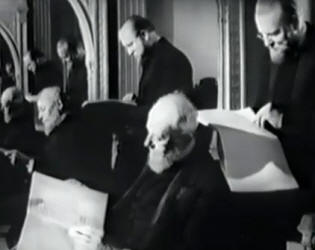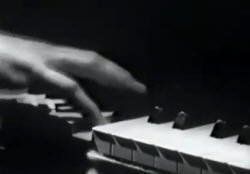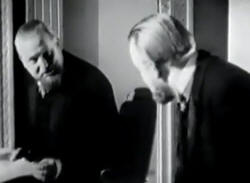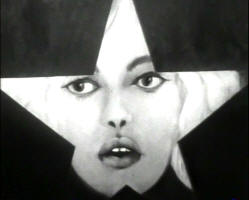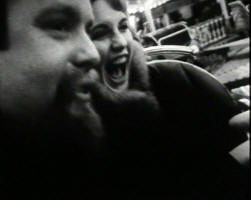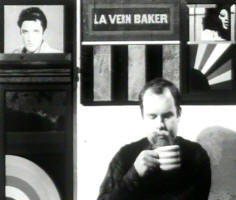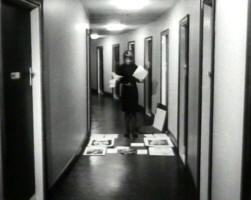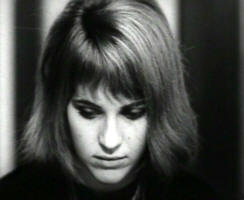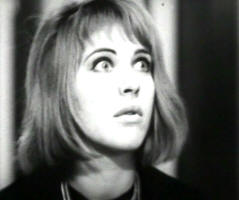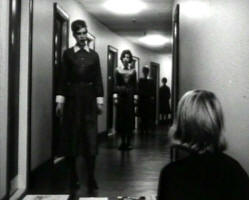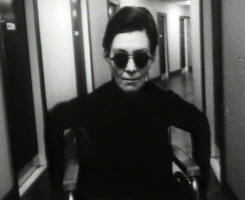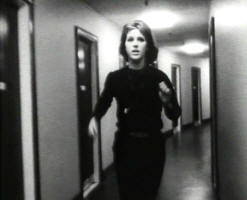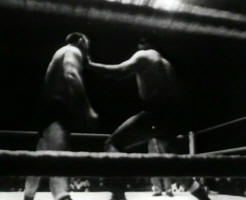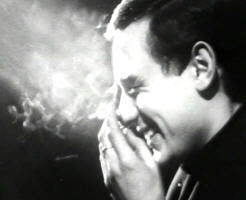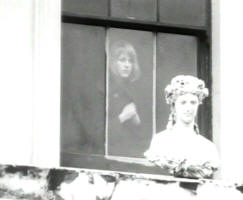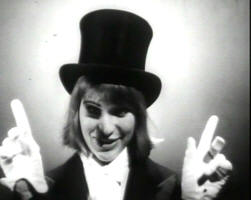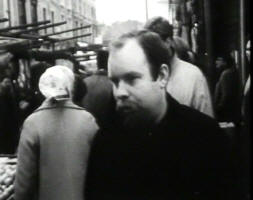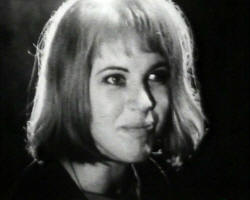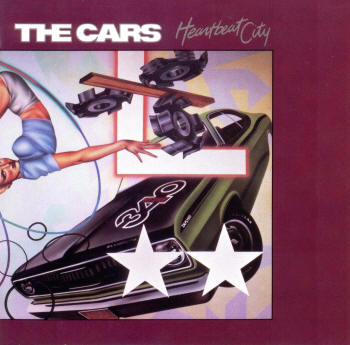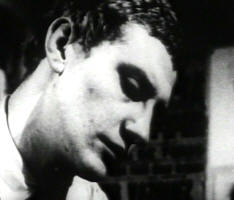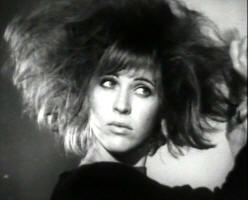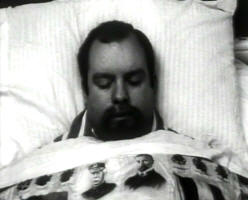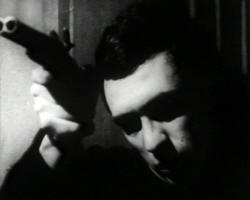|
Working for the BBC´s Monitor arts programme Ken was allowed to develop from 15 minute shorts to longer films, and he produced some of his best work in this period. He had a professional organisation backing him up, but also had to cope with limited acting resources. His inventiveness is remarkable and he combined highly artistic films with wide commercial success: he became the most sought after documentary director. Says Russell we made films on living artists and when there were no more of them left we turned to making films about dead artists. 1961 Portrait of a Soviet composer
Ken Russell's first longer (28 minutes) television film from 1961 about the composer Prokofiev. The producer Huw Wheldon initially did not want actors in the documentaries. Russell gradually worked around this, initially for the Prokofiev film showing only the hands and back of the actor, and once the actor reflected in water. Interestingly this only applies to the actor playing Prokofiev. The actor playing the critic is shown in full and even talks in one scene.
The famous mirror scene converts two actors into a crowd. At one point an actor is arguing with his own image in the mirror. Russell uses the same trick in other films.
"Huw Wheldon, editor-in-chief of the BBC's Monitor arts strand,
was resolutely opposed. Wheldon firmly believed that documentaries
should only contain actual footage of their subject, and that
reconstructing unfilmed events was tantamount to deceiving the viewing
public. The film includes Prokofiev´s music for Eisenstein's Alexander Nevsky, which Russell parodied in Billion Dollar Brain. Similarly the historical footage of the Russian revolution, is also Eisenstein's film Oktober. Eisenstein used actors to recreate history but Russell was not yet allowed to do so. The Music Lovers shows heavy influence of Portrait. The Music includes
A biography of four pop artists (art not music). The title is a pun on the expression pop goes the weasel. This was the first documentary to treat pop-art as a serious movement rather than as a joke. Unfortunately the four artists Derek Boshier, Pauline Boty, Peter Blake and Peter Phillips and have not stood the test of time with only Blake retaining minor acclaim. The four artists, who seem to live in a sort of commune, play with cowboy guns (edited with a cowboy firing back) or try and fail to look natural in front of the camera as they discuss their work. The programme is introduced by Huw Wheldon and after this formal beginning it moves into mixtures of art and music (Buddy Holly etc), the film itself very much in pop art style. "No one spoke much in [the film], which was unusual for Monitor. When Huw saw the film, he said 'Brilliant, old boy. brilliant, but you don't show the artists at work... Won't do old chap, got to show a bit of paint on the canvas, a bit of pigment on the palette.' So I [Russell] went back and shot them painting and he was delighted" (Paul Ferris, Sir Huge: The Life of Sir Huw Wheldon, Michael Joseph, 1990 ch 7).
"The cinematic language... references the early films of the French nouvelle vague, including François Truffaut’s Les quatre cents coups (The 400 Blows, 1959) and Jean-Luc Godard’s À bout de souffle (Breathless, 1960)." (John Wyver, The Filmic Fugue of Ken Russell’s Pop Goes the Easel, Journal of British cinema and television, 2015, Vol.12 (4), p.438-451).
The best scene is a dream sequence where Pauline Boty is chased round corridors by a woman in a wheelchair. The dark glasses and hands pulling the wheels forward are genuinely menacing. Sue Watling and David Alan Mellor state "Unlike the other three artists she does not get an opportunity to speak seriously or directly about her work. Instead she acts out a deranged mock-horror, fantasy sequence" (Pauline Boty, The Only Blonde in the World, 1998). However the BBC documentary Pauline Boty: I Am the Sixties, first shown 3 Mar 2025, states the sequence was "her own nightmare, her own idea". The woman running down the long curved corridor comes back in Ken Russell's Trapped Ashes 46 years later. "Innovative in style and content, it places Boty at the centre of emergent British pop. Her much admired wall collage sets the tome for the whole piece and we get to see her collages and some paintings. However the film also exposes the deep problems for women engaged in the genre. Unlike the other three artists she does not get an opportunity to speak seriously or directly about her work. Instead she acts out a deranged mock-horror, fantasy sequence [Iain: !!!!]. Russell does not present her as the artist acting on popular culture, but as an actress subsumed by those sources" (Pauline Boty, The Only Blonde in the World, Sue Watling and David Alan Mellor, 1998). Restricted by black-and-white Russell handles the colour artworks well, but compared with for example Savage Messiah the subjects are can't carry the film and end up looking very pretentious. Tony Hancock's The Rebel from 1961 covers the same material satirically (with Oliver Reed as one of the artists). The party sequence is copied later in Song of Summer and there is a scene playing pinballs (Tommy).
Glimpses of the future: Pauline Boty looks wistfully out the window reminiscent of Glenda Jackson at the end of The Music Lovers, and she sings (well, mimes) I'm Forever Blowing Bubbles as if she was in The Boyfriend. The scene from a Fred Astaire musical is similar to what Russell would achieve with The Boyfriend. All four go to a wrestling match which presages Women in Love, and there is a pinball machine. The photography throughout is beautiful, black and white atmospheric imagery reflecting Russell's background as a photographer.
"Throughout Pop Goes the Easel, not only does Russell overturn the dominance of word over image in the arts on television through to 1962, but he also skillfully weaves his filmic fugue from the various pairings of concerns, alternating and counterpointing... in this film especially, but also in other films that he went on to create for Monitor, Russell’s achievement deserves celebration" (John Wyver, The Filmic Fugue of Ken Russell’s Pop Goes the Easel, Journal of British cinema and television, 2015, Vol.12 (4), p.438-451). "The attention paid to the pop artist Pauline Boty, who is currently enjoying one of her periodic rediscoveries, has been attributed by the Scottish novelist Ali Smith to four people: alongside the two curators/art historians who tracked down and rescued her paintings were her dairy farming sister-in-law, who kept them in a barn for years after Boty’s untimely death from cancer aged 28, and Ken Russell, who included her in his enduringly influential 1962 film Pop Goes the Easel" (The Guardian, 22 Dec 2023, click here). Camera is by Ken Higgins (Elgar, French Dressing), editor is Alan Tyrer (Elgar). Derek Boshier would later appear in Dante's Inferno playing Millais, and Pauline Boty would appear in Bartok, more painters turned Russell actors. In a revival of the film twenty years on, the three male artists discuss the film- Pauline tragically died a few years after the making of Pop Goes the Easel. The music includes
Site visitor Adam Smith adds (thanks Adam):
Click on the arrows for more films |
|
|
|
|
